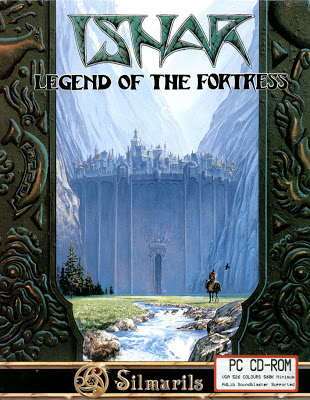From The CRPG Addict
 |
| Our hero does . . . something . . . in celebration of his victory. |
Ishar: Legend of the Fortress
France
Silmarils (developer and publisher)
Released in 1992 for DOS, Amiga, and Atari ST
Date Started: 22 February 2020
Date Finished: 10 March 2020
Total Hours: 21
Difficulty: Moderate-Hard (3.5/5)
Final Rating: (to come later)
Ranking at time of posting: (to come later)
Summary:
First of a trilogy for which Crystals of Arborea (1990) served as a prologue, Ishar offers a classic kill-the-evil warlord adventure with tile-based, first-person gameplay similar to Dungeon Master or Eye of the Beholder. It has excellent graphics and sound but limited RPG mechanics, including combat and spell tactics, character development, inventory, and puzzle-solving. A couple of original features include a party morale system by which party members can override the player’s choice to recruit or dismiss a character and a saving system that requires the party to pay gold, but neither really plays much of a role in the end.
****
I could have gotten three more entries out of
Ishar, as this final entry covers more than 15 hours. But I played it over a week-long period in which I was moving from one house to another, and something about the process made it easier to just keep playing than to stop and write. I apologize if I elide anything important in my summary below, but the good news is that a lot of
Ishar‘s gameplay is repetitive. The constant need to replenish your supplies and find a tavern for food and sleep means that you backtrack frequently to the towns of the west while overall gameplay drives you east.
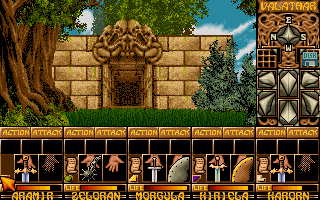 |
| Approaching the titular fortress. |
When I blogged last time, I had explored about half the game, having just crossed the bridge into the land of Silmartil. Lands further along include Kandomir, Urshurak, Vargaeon, Baldaron, Zendoria, Gil-Aras, Uldonyar, Elwingil, Halindor, Fhulgrod, and finally Valathar. That sounds like a lot of territories, but each one generally only has a couple of (respawning) monsters and a couple of encounters. The entire game world consists of four outdoor villages, two indoor cities, two dungeons, and a smattering of huts and other wilderness encounters. It spreads across the entire game what Might and Magic would have on a single 16 x 16 map.
The culmination of the game was far to the east, in the large dungeon (or, I suppose, fortress) actually called Ishar. But to survive its perils, I had to solve several sub-quests in the main game area.
When I last blogged, my party consisted of Aramir the warrior (the starting character), the monk “Unknown,” Nasheer the spy, Kiriela the priestess, and Golnal the warrior. Golnal and Unknown were pretty ineffective, and redundant, so I soon replaced Golnal with a paladin named Karorn, and eventually I dumped Unknown for a wizard named Zeloran. To get around party members overriding my dismissals, I simply put the unwanted characters at the front of the party with no armor, and I let them get killed by the next enemy.
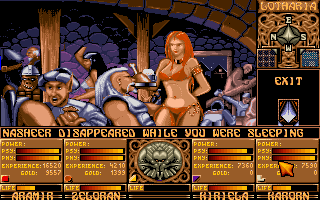 |
| This is infuriating. I don’t know why some NPCs do it and some don’t. |
Naheer eventually took off while we were sleeping, so I replaced her with a third warrior named Manatar. I liked that balance, but soon afterwards I had to get rid of Manatar to accommodate a quest NPC–a spoiled princess named Deloria who had been kidnapped from her village in Baldaron. I found her in a building in Elwingil, the furthest city to the east.
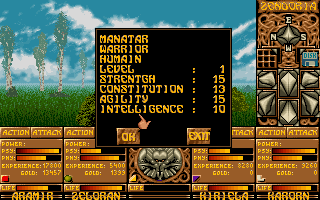 |
| Manatar had good stats, but he wasn’t with us for long. |
Returning her to her father rewarded the party with a vital key to Ishar, but getting her out of the party was a bit of a chore. Karorn decided he was in love with her and refused to let her go. I tried killing Karorn, but his infatuation simply transferred to Aramir, and I didn’t want to kill him.
 |
| Oh, boy. Here we go. |
The solution to that problem involved a potion. Potions become important in the game during the second half, and it took me a while to figure out how they work. First, you have to find an empty vial, of which there is only one in the entire game, in the dungeon in Rhudgast.
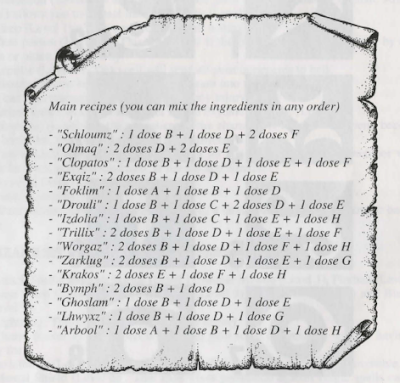 |
| The manual gives you the formulas but not the effects. |
I had previously noted that various shops sell reagents like rat’s brains and salamander oil. The manual tells what proportions of these reagents you need to make various potions, but it gives them nonsense names like “Trillix” and “Bymph.” What you have to do is find an alchemist named Jon the Unique in Kandomir, who gives you a scroll that translates the nonsense names into actual potion effects. (I think these might be randomized for each game as a copy protection exercise, but I’m not sure.) The manual has recipes for 15 potions, but the scroll only translates eight of them: “Physical Regeneration,” “Psychic Regeneration,” “Invulnerability,” “Cure Blindness,” “Apnea,” “Disrupt Charme,” “Pig Detransformation,” and “Brain Wash.”
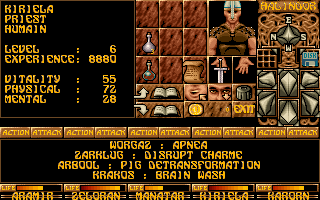 |
| A scroll in the game tells you which words correspond to which effects. |
“Disrupt Charme” turned out to be the potion I wanted, but it required a unique ingredient, “turtle slobber.” Fortunately, I’d managed to obtain a vial by first finding a turtle near the sea in Silmatil and then giving it to an alchemist in Zendoria. I fed the potion to Karorn, and he got over his objection to losing Deloria.
 |
| Where did Jarel get the key to Ishar? |
By this time, I was so enamored with my wizard, Zeloran, that I decided to fill the empty NPC slot with another one. I found one named Khalin in Elwingil. I spent a fortune getting them both equipped with the “Lightning” spell, which damages all visible enemies on the screen and makes wizards more valuable than warriors except that psychic energy runs out faster than physical energy.
 |
| Blasting dwarf-bandits with “Lightning.” |
A lot of the game’s magic system is wasted. It costs so much to purchase spells that even by the end of the game, each of my spellcasting characters only had three or four. There’s no point wasting money on “Healing 3” when three castings of “Healing 1” do the same thing. I never explored a lot of useful-sounding spells like “Dissolve” (turns the party into a gas cloud that can blow through enemies) or “Inversion” (changes NPC alignments). Some of them seem useless–I never encountered any poison for “Cure Poison” or any invisible enemies for “Invisibility Detection” (except for one that you can’t detect that way). “Radar,” “Invisible Party,” and “Invulnerability” aren’t even described in the manual, just listed. “Regeneration,” “Resurrection,” and “Repulse” (sends all your enemies to hell!) could have been useful but I just never had the money. I basically had my wizards cast “Lightning” (and “Mental Shield” when it was clear it was needed) and my priest and paladin cast “Healing I,” and that was it.
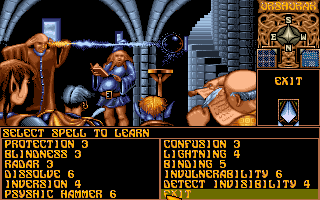 |
| I never learned most of these spells. |
Money is tight throughout the game. You need it for sleeping and eating–one meal and one night’s rest costs over $2,000 in the eastern cities–saving ($1000 each), reagents (enough for a single potion might cost $7,000), spells, weapons and armor, and the occasional training. The shop in Elwingil sold high-level weapons and armor, and by the end of the game I was able to get my two warriors into magic armor and wielding the best swords, but no one else. I spent most of my spare gold on potion reagents because potions of “Physical Regeneration” and “Psychic Regeneration” are worth every penny if you’re far from a tavern.
Meanwhile, the places that train characters in strength, agility, and intelligence (I never found one that trained constitution) seem to be there to compensate for very weak characters, not to provide regular character development to already-strong ones. Every time you try to train, there’s a chance that it will go very well (increasing the attribute by 2 points), just okay (+1), or poorly (+0). I don’t think I ever saw an attribute increase when it was already past 10. Thus, for most characters the only form of development is by leveling, which improves maximum health. Several of my characters hit level caps (Level 10) near the end of the game, but not everyone did.
I grinded quite a bit for my gold and still arrived at Ishar mostly broke. (Ishar itself has tens of thousands of gold pieces, but you’d have to slog them back to civilization while very near the endgame.) I decided the best way to grind was to repeatedly enter and exit the two indoor cities in Elwingil and Urshurak. Each one spawns about half a dozen orcs that leave 500 or 1000 gold pieces each. Repeatedly entering and exiting the city was a good way to build both wealth and experience.
By killing a large knight in Osghirod, I got a special helmet that allows you to see invisible enemies. This let me kill the invisible lizardman Brozl, who roams the huge area called Fimnuirh, and to loot from him five fire protection rings.
I spent a lot of time tracking down five rune tablets that you need for the final battle, or you can’t hit Krogh. One was out in the open, on a pedestal in Lotheria. A second was in a hut in Zendoria called “The Forbidden House,” so-named because my characters got cursed and slowly died of a wasting sickness after entering. I had to inoculate them with a potion before entering. Another was in the dungeon in Rhudgast. A fourth was on a pedestal in the outdoor area called Gil-Aras, but the party went blind the moment I entered the province. I had to use the “Cure Blindness” potion to see well enough to explore the small area. The fifth was in Ishar itself.
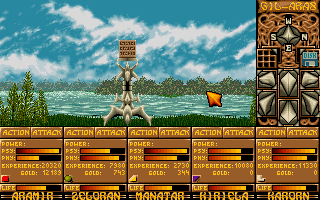 |
| A rune tablet in an area that causes blindness the moment you enter. |
In a house in Elwingil, one of Jarel’s companions from Arborea, Thurm, gave the party five monks’ robes that would disguise us as initiates in a certain place in Ishar.
Eventually, having explored everything else, I entered a teleporter in Halindor and found myself across the channel in Valathar. The entrance to Ishar is in the northeastern part of this island, but there were a few things to do first, including defeating the wizard the guarded the entrance. In the far southeast past some encounters with much tougher dwarf-bandits than I’d faced before, I found a pig standing in the middle of the forest. Since a wandering alchemist had recently given me some toad eye, a necessary ingredient for “Pig Detransformation,” I figured that’s what I wanted to use. I mixed the potion and applied it to the pig, and it transformed into an old woman named Morgula who offered to join my party.
 |
| When there’s a potion called “Transform from Pig” and you find a pig, it’s not hard to figure out what to do. |
If was reluctant to get rid of Khalin, but I figured Morgula must be special in some way since I had to go through so much trouble to get her. Sure enough, although she’s weak as hell and her physical energy depletes while you watch, she has a spell called “Anti-Krogh.” After I won the game and was doing my usual post-game research, I found that several web sites claim that Morgula is Krogh’s mother, but I don’t know where they get that, as her name appears nowhere in the backstory or in any of the NPC dialogue.
 |
| How do you turn down that kind of appeal? |
It was finally time to take on Ishar. The fortress is quite large, with three separate sections separated by teleporters. There are numerous doors that you have to find keys to open, and one area that serves as the game’s only real puzzle: a sequence of six levers, each controlling two doors in a small maze of corridors. You have to find the right sequence of levers to open the right doors, which I did through trial and error. There’s a huge area full of poison gas that you have to mix five “Apnea” potions to successfully traverse.
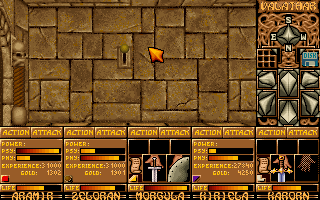 |
| A lever puzzle took much of the time in the final dungeon. |
At one point, I killed a mage and looted from him an object that looks like the Silmarils logo, but I never found anything to do with it.
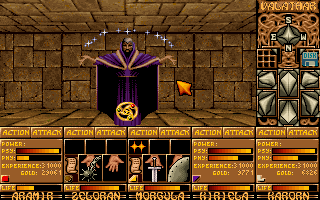 |
| Anybody want to take a guess? |
The final corridor features multiple encounters in succession. First, a medusa, for whom you need “Mental Shield” active for everyone to avoid petrification.
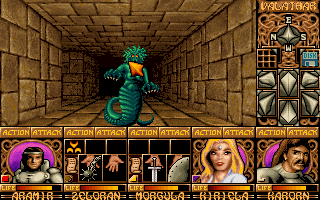 |
| Why does it look like medusa is a statue? She’s supposed to turn people into statues? |
Then there’s a huge red dragon. It takes a long time to kill him–and my primary fighter had to drink two “Physical Regeneration” potions during the process–but he doesn’t do much damage as long as you have the gold rings from Brozl.
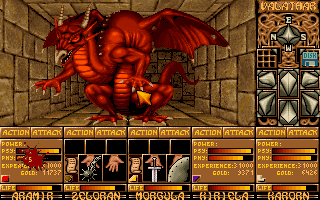 |
| Poor dragon looks like he’s cramped. |
After the dragon was a door we had to be wearing our robes to enter . . .
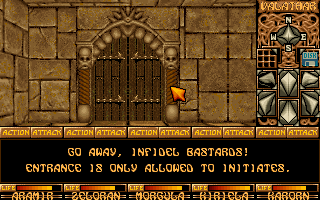 |
| This is the first I’ve heard of Krogh starting some kind of cult. |
. . . then a corridor full of individual fights with spellcasters.
 |
| Killing wizards in the final corridor. I thought this was Krogh at first. |
It all culminated with Krogh himself. He had a powerful magic attack, but it only took three castings of “Anti-Krogh” to kill him. I assumed it would be harder. I guess maybe it is if you don’t take Morgula.
 |
| The evil Krogh. Fortunately, Morgula has a spell called “Anti-Krogh.” |
Alas, there was no real endgame. After Krogh died, the game played some triumphant music while one of my characters–Aramir, I guess–knelt in a circle of rotating pillars and held a crown above his head.
One element of the game that I never solved: there’s a sword in a stone that was supposedly left there by Jarel when he swore off violence. Despite the message, I couldn’t pull it out at any level or with the highest strength statistics.
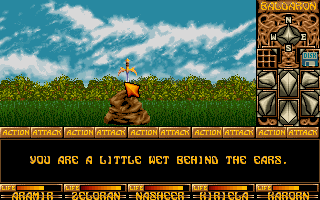 |
| Any ideas? |
In a GIMLET, the game receives:
- 3 points for the game world. I like the layout, but otherwise it’s a generic high-fantasy place with a generic high-fantasy quest. 1992 CRPG addicts are no longer satisfied with vaguely-described evil overlords trying to take over the world just because they’re evil.
- 3 points for character creation and development. There’s no creation process, just an assemblage of party members from the NPCs you find across the land. Development is quiet, almost invisible, and besides those of wizards and warriors, the game really doesn’t call upon the varied skills of its other classes.
- 4 points for NPC interaction. There are a few fixed NPCs who provide hints and items, and then there are the NPCs who can join the party. I’ll allow a point for the uniqueness of Ishar‘s approach to alignment, where party members must vote to admit or expel new members, and apparently you can order one NPC to kill another, perhaps creating ramifications down the line (I never explored this), but none of it amounted to anything.
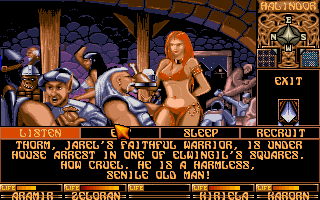 |
| A few unnecessary hints do not constitute much in the way of “RPGs.” |
- 2 points for encounters and foes. There aren’t really any non-combat encounters, and monsters are generic high-fantasy denizens with the standard types of attacks. They’re not even named on-screen. I thought the respawn rate was useful.
 |
| Here was a powerful thing from inside the final dungeon. |
- 2 points for magic and combat. Even if I’d bought all the spells, I don’t think they really would have afforded much in the way of combat “tactics.” There isn’t much to do in combat but attack, cast, and keep an eye on the related meters. The party deployment grid is mostly wasted, and you can’t even do the “combat waltz” or other strategies common to Dungeon Master-style games.
- 4 points for equipment. You have a reasonably good selection of weapons and armor, with numbers denoting their relative effectiveness. The potion system isn’t bad except that you only have one flask.
 |
| This shop in Elwingil offers the best weapons and armor. |
- 6 points for the economy. It remains relevant to the end, and I like the way that it forces you to make tough choices throughout the game. It just lacks a certain complexity that I would need for a higher score, plus perhaps more of a “money sink” in those attribute trainings.
- 2 points for a main quest with some sub-quests but no side-quests. There are no alternate endings or player choices.
- 6 points for graphics, sound, and interface. The graphics and sound are some of the best we’ve seen, just about perfect for the scale and nature of the game. I particularly appreciated the ambient sounds (including a murmur of voices in the taverns that I came to believe was “I’m riding down to Livermore with some recruits”). The music is suitably epic, though in my case turned off. The interface was only okay; too much mouse, too little keyboard.
- 6 points for gameplay. It has some minor nonlinearity and minor replayability (with a different party configuration). It’s almost perfect in its challenge (including its enforcement of limited saving) and its length.
That gives us a
final score of 38. That seems about right. I was thinking that it should at least cross into “recommended” territory, but in the end the game is too sophomoric in core RPG mechanics to break into the “truly good” range.
I expected the Amiga version to do quite well in European reviews (most U.S. publications, including Computer Gaming World, don’t seem to have taken note of it), so I was surprised to find mostly low scores even in Amiga magazines. Scores ranged from 48 (Power Play, September 1992) to 89 (CU Amiga, July 1992). The consensus seems to be the same as mine: the graphics are great, but it lacks in RPG mechanics like combat and character development, and it doesn’t have much of a plot. A few noted that with a Dungeon Master-style interface, they expected Dungeon Master-style puzzles. A paragraph from the British Amiga Action (July 1992), which gave it an 82, is representative:
Noticeably distinguished in the graphics area, Ishar: Legend of the Fortress plays almost as well as it looks . . . Perhaps the downfall of Ishar is its simplicity; you begin to wish for more activity, interaction, and involvement, more problems and less roaming . . . Certainly a valiant effort by Silmarils and, if they can learn from this, a firm foundation for a sequel.
Not everyone felt as positively as I did about the pay-to-save mechanism. My fellow blogger, Saintus,
abandoned it after one session for that reason. Magazines, if they mentioned it, mentioned it negatively. In contrast, a lot is made in the magazine reviews about the party morale or alignment system in which characters form bonds, defy orders, and “have their own personalities,” none of which is reflected in the game in any interesting way. I suppose
Ishar did some trailblazing here, but I’ll concede that an NPC “has his own personality” when he actually says something. Yes or no votes on other party members aren’t quite enough.
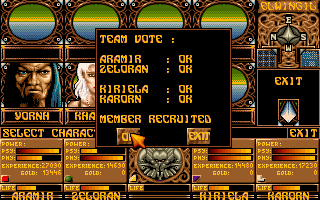 |
| Does this really add that much? |
Silmarils will have plenty of opportunities to continue to improve on this system.
Ishar 2: Messengers of Doom will be along in 1993 and
Ishar 3: The Seven Gates of Infinity in 1994. We also might have them for
Robinson’s Requiem (1994) depending on my decision on the genre. After that, Silmarils changes its focus to action games and ultimately goes out of business in 2003.
Although some commenters have suggested a certain amount of “Frenchiness” to this game, I think it’s safe to say that we’ve long-since exited the era of truly outré French titles like Mandragore (1985) and Tera: La Cité des Crânes (1986). Instead, Silmarils seems to be following early-1990s Germany by producing copies of successful American games, albeit with some of their own twists. I’ll miss the bizarre nature of the 1985-1989 French “golden age,” but then again there are still a few titles on my clean-up list.
I gave the choice of the next “upcoming” game to Sebastian, who designed my banner, and he opted for Lands of Lore (1993). That’ll be along in a few games. Next we’ll finally take a look at Planet’s Edge.
Original URL: http://crpgaddict.blogspot.com/2020/03/ishar-legend-of-fortress-won-with.html


























